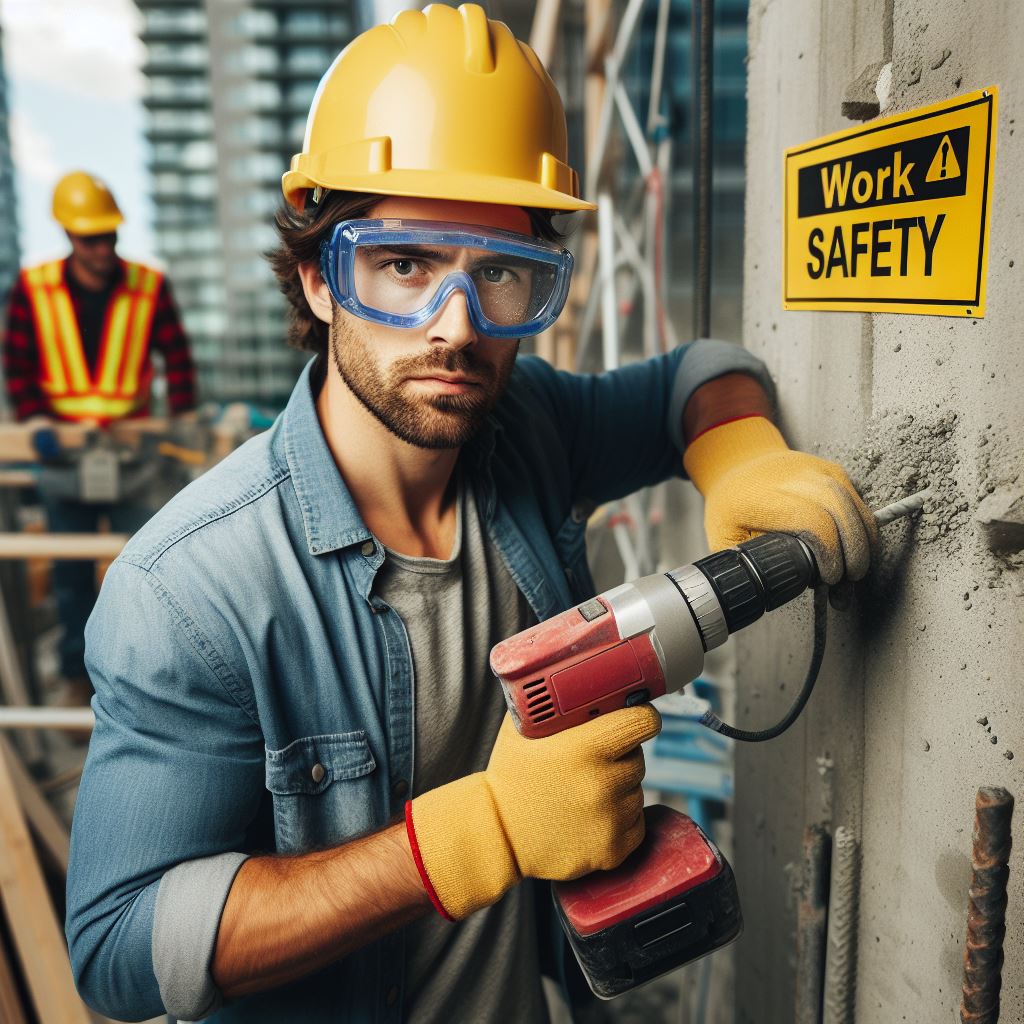Introduction
A. Importance of physical fitness for builders
Physical fitness is crucial for builders as it can improve their overall performance and reduce the risk of injuries.
In this blog post, we will explore the importance of physical fitness for builders and provide practical tips to help them stay fit and healthy.
By the end of this post, readers can expect to learn effective fitness strategies to enhance their strength, endurance, and flexibility, ultimately enabling them to excel in their roles as builders.
Physical fitness plays a vital role in the lives of builders.
Regular exercise and training help them develop strong muscles, improved cardiovascular health, and enhanced coordination.
This, in turn, enables them to handle physically demanding tasks with ease and efficiency.
B. Purpose of the blog post
The purpose of this blog post is to equip builders with valuable fitness tips that can maximize their physical capabilities and promote long-term well-being.
Readers can expect to learn about the importance of proper warm-up and stretching exercises, the benefits of incorporating strength training into their routine, and strategies to enhance endurance and stamina.
Additionally, nutrition tips and injury prevention techniques will also be covered to ensure builders’ overall physical fitness.
By following the guidance provided in this blog post, builders can enhance their performance on the job site, reduce the risk of injuries, and improve their overall quality of life.
Developing a regular fitness routine and prioritizing physical well-being will not only benefit builders personally but also contribute to their professional success.
Stay tuned for the upcoming sections as we delve into specific fitness tips and techniques tailored specifically for builders in the construction industry.
Benefits of Physical Fitness for Builders
A. Impact of Physical Fitness on Overall Health, Energy Levels, and Mental Well-being
- Physical fitness improves overall health by reducing the risk of chronic diseases such as heart disease and diabetes.
- Regular exercise boosts energy levels and reduces fatigue, allowing builders to perform their tasks more efficiently.
- Engaging in physical activities releases endorphins, which enhance mental well-being and reduce stress and anxiety.
- Improved cardiovascular health from being physically fit increases stamina and endurance, helping builders maintain their performance throughout the day.
B. Reduced Risk of Injuries on the Job
- Being physically fit strengthens muscles, ligaments, and bones, reducing the risk of strains, sprains, and fractures at work.
- Regular exercise improves flexibility and range of motion, which reduces the chance of injuries during physically demanding tasks.
- Building core strength through exercises such as planks and squats enhances stability and balance, preventing falls and accidents.
- Maintaining a healthy body weight through physical fitness lowers the risk of joint problems and other work-related injuries.
Incorporating physical fitness into the routine of builders provides numerous benefits.
It positively impacts overall health, energy levels, and mental well-being.
Moreover, being physically fit significantly reduces the risk of job-related injuries.
By prioritizing their fitness, builders can enhance their performance, longevity, and overall quality of life.
Read: Tips for Managing a Construction Team
Exercise Recommendations for Builders
A. Incorporating Cardiovascular Exercises
Improving endurance and stamina should be a priority for builders to perform their physically demanding work efficiently.
Incorporating cardiovascular exercises into their routine can greatly enhance these aspects.
Cardio exercises like jogging, cycling, swimming, and jumping rope can be beneficial for increasing heart rate and improving lung capacity.
Such exercises help builders build up their cardiovascular endurance, enabling them to withstand long hours of continuous physical labor without feeling excessively tired or out of breath.
Regular aerobic activities can also provide other long-term health benefits, such as reducing the risk of cardiovascular diseases and improving overall heart health.
It is recommended that builders aim for at least 150 minutes of moderate intensity or 75 minutes of vigorous intensity cardio exercises per week.
B. Strength Training Exercises for Builders
In construction work, builders often encounter tasks that require significant physical strength.
Incorporating strength training exercises into their workout routine can help prevent muscle imbalances and improve overall strength.
Unlock Your Career Potential
Visualize a clear path to success with our tailored Career Consulting service. Personalized insights in just 1-3 days.
Get StartedStrength training exercises that target muscles commonly used in construction work, such as the legs, back, shoulders, and arms, should be prioritized.
Squats, lunges, deadlifts, and leg presses are excellent exercises for strengthening the leg muscles, which are crucial for lifting heavy materials and equipment.
Upper body exercises like pull-ups, push-ups, and shoulder presses can help strengthen the back, arms, and shoulders, enabling builders to handle heavy tools and materials effectively.
It is essential for builders to maintain proper form while performing strength training exercises to avoid injuries. Gradually increasing weights and reps is also recommended to progress effectively.
C. Significance of Flexibility Exercises
Flexibility is another crucial aspect for builders to prevent injuries and enhance mobility.
Engaging in flexibility exercises regularly can help improve range of motion, allowing builders to perform tasks more efficiently.
Stretching exercises like hamstring stretches, quad stretches, and shoulder stretches can help alleviate muscle tightness and improve flexibility in relevant areas.
Improved flexibility can prevent muscle strains, sprains, and other common injuries that can hinder a builder’s ability to work effectively.
Yoga and Pilates are also excellent forms of exercise that combine strength, flexibility, and balance, further aiding builders in their physical fitness goals.
It is recommended for builders to incorporate stretching exercises into their warm-up and cool-down routines and perform them regularly to improve flexibility over time.
Basically, for builders to maintain optimal physical fitness:
- Cardiovascular exercises should be incorporated to improve endurance and stamina.
- Strength training exercises must target muscles commonly used in construction work.
- Flexibility exercises should be engaged in regularly to enhance mobility and prevent injuries.
By following these exercise recommendations, builders can improve their overall fitness levels, reduce the risk of work-related injuries, and perform their construction tasks more efficiently.
Remember, consistency and proper form are key to achieving the desired results.
Read: Construction Projects That Shaped Canada
Warm-up and Cool-down Techniques
A. Importance of warming up before engaging in physical activities
Warming up before engaging in physical activities is extremely important for builders.
It helps prepare the body for the upcoming workout and reduces the risk of injuries.
Here are some examples of dynamic warm-up exercises suitable for builders:
- Jumping Jacks: Start with your feet together and arms by your sides. Jump while simultaneously spreading your legs and raising your arms above your head. Return to the starting position and repeat.
- Walking Lunges: Take a step forward with your right foot, lower your body, and bend both knees to a 90-degree angle. Push up and bring your left foot forward into the next lunge. Repeat alternatively.
- Arm Circles: Stand with your feet shoulder-width apart. Extend your arms to the sides and make small circles in a forward direction. Gradually increase the size of the circles.
- High Knees: Stand tall and jog in place while lifting your knees as high as possible. Engage your core and pump your arms to maintain a good rhythm.
- Shoulder Rolls: Stand with your feet shoulder-width apart and arms relaxed by your sides. Roll your shoulders forward in a circular motion, starting with small circles and gradually increasing the size.
Cooling down after physical activity is just as important as warming up.
It allows your body to gradually return to its normal state and reduces post-workout muscle soreness.
B. Appropriate techniques for builders
Here are some appropriate techniques for builders:
- Walking: After intense exercise, slow down your pace and go for a gentle walk for 5-10 minutes. This helps flush out lactic acid and aids in recovery.
- Stretching: Focus on stretching the major muscle groups used during your workout. Hold each stretch for 15-30 seconds without bouncing.
- Foam Rolling: Use a foam roller to target specific muscle groups and release tension. Roll slowly back and forth over the areas that feel tight or sore.
- Deep Breathing: Take deep breaths in through your nose and slowly exhale through your mouth. This helps calm your body and bring your heart rate back to normal.
- Hydration: Drink plenty of water during and after your workout to replace the fluids lost through sweating. This aids in the recovery process.
By incorporating these warm-up and cool-down techniques into their routine, builders can improve their physical fitness and protect themselves from potential injuries.
Remember, proper preparation and recovery are essential for optimal performance.
Read: Mental Health Support for Builders

Proper Body Mechanics
Builders lead physically demanding lives, constantly maneuvering heavy objects and working in challenging environments.
In order to prevent injuries and ensure long-term physical well-being, it is crucial for builders to prioritize proper body mechanics.
This involves maintaining correct posture and employing safe lifting techniques throughout their work activities.
A. Significance of maintaining proper posture and body mechanics during work activities
Emphasizing the significance of maintaining proper posture and body mechanics during work activities is vital.
Good posture not only helps prevent aches and pains but also promotes optimal muscle function and overall physical health.
By ensuring that the spine is aligned correctly and muscles are balanced, builders can reduce the risk of developing musculoskeletal issues and chronic conditions such as back pain.
B. Potential consequences of poor posture and improper lifting techniques
Poor posture, on the other hand, can have detrimental consequences.
Slouching or hunching over while working can put excessive strain on the spine, leading to discomfort and potential long-term damage.
It can also affect the alignment of other joints, such as shoulders and hips, which can result in imbalances and further increase the risk of injury.
By maintaining proper posture, builders can avoid these issues and work more efficiently and comfortably.
Another crucial aspect of proper body mechanics is using correct lifting techniques.
Improper lifting can cause immediate injuries, such as strained muscles and herniated discs.
Moreover, repeated incorrect lifts can lead to chronic conditions, making it essential for builders to learn and practice safe lifting methods.
C. Tips on how builders can maintain correct body alignment and lift heavy objects safely
To maintain correct body alignment and lift heavy objects safely, builders should follow these tips:
- Warm up: Before beginning any lifting activity, it is important to warm up the muscles and increase blood flow to prevent injuries.
- Use your legs: When lifting heavy objects, the power should come from the legs, not the back. Bend at the knees and use the leg muscles to push upwards.
- Keep a neutral spine: Maintain the natural curves of the spine while lifting, avoiding excessive rounding or arching.
- Engage core muscles: Activating the abdominal and back muscles provides additional support to the spine during lifting.
- Hold objects close to the body: Carrying objects away from the body increases the strain on the muscles and joints. Keep items as close as possible to reduce the load.
- Avoid twisting: When carrying objects, pivot with the feet rather than twisting the torso, as twisting can strain the spine and lead to injuries.
- Ask for help: It is essential to recognize one’s limits. When faced with an object that is too heavy or difficult to lift alone, seeking assistance is crucial.
- Take breaks: Engaging in repetitive lifting tasks without breaks can exhaust the body. Taking regular breaks allows for rest and recovery.
Implementing these tips can significantly reduce the risk of injuries and enhance builders’ overall physical fitness and well-being.
By prioritizing proper body mechanics, builders can continue to excel in their work while minimizing the potential long-term impact on their bodies.
Read: Best Footwear for Construction Workers
Nutrition and Hydration
In the demanding world of construction, physical fitness is not just a luxury; it’s a necessity.
Builders face a unique set of challenges, from lifting heavy materials to enduring long hours on the job.
To excel in this physically demanding profession, a strategic approach to nutrition and hydration is paramount.
A. The Power of Nutrition
- Balanced Diet Boost: A builder’s diet is the cornerstone of their physical well-being. Consume a balanced mix of carbohydrates, proteins, and healthy fats.
- Protein Prowess: Prioritize protein intake to aid muscle recovery and growth. Incorporate lean meats, dairy, and plant-based sources like beans and lentils.
- Nutrient-Rich Choices: Opt for nutrient-dense foods such as fruits, vegetables, whole grains, and nuts to provide sustained energy throughout the day.
B. Building Blocks of a Balanced Diet
- Complex Carbs for Endurance: Choose complex carbohydrates like whole grains and oats to sustain energy levels during strenuous activities.
- Healthy Fats Matter: Include sources of healthy fats, like avocados and nuts, to support overall health and provide a slow-burning energy source.
- Mindful Eating: Eat smaller, more frequent meals to maintain energy levels and prevent energy crashes during the workday.
C. Snack Smart, Work Strong
- Grab-and-Go Options: Opt for convenient, nutritious snacks such as trail mix, yogurt, or pre-cut veggies to keep energy levels steady.
- Hydration Heroes: Choose water-rich fruits like watermelon and cucumber to contribute to both hydration and nutrient intake.
- Prep Ahead: Prepare healthy snacks in advance to resist the temptation of less nutritious on-site options.
D. Hydration for Peak Performance
- Sip, Don’t Slurp: Maintain a steady intake of water throughout the day. Sipping water consistently is more effective than chugging large amounts infrequently.
- Electrolyte Balance: Consider electrolyte-rich drinks, especially in high-temperature environments, to replenish salts lost through sweat.
- Strategic Hydration Breaks: Schedule regular breaks for hydration, especially during physically demanding tasks, to prevent dehydration and enhance performance.
By embracing these nutrition and hydration strategies, builders can fortify their bodies for the demanding rigors of the job, ensuring they have the strength and stamina to build a solid foundation for success.
Rest and Recovery
Rest and recovery periods are crucial for builders to maintain their physical fitness.
Taking time to rest allows the body to repair and rebuild muscles, reducing the risk of injury and improving overall performance.
A. The Importance of Rest and Recovery
For builders, who engage in intense physical activities, rest and recovery are essential for several reasons:
- Preventing Overuse Injuries: Rest periods help prevent overuse injuries, such as strained muscles or joint problems, which can occur from repetitive movements.
- Muscle Repair and Growth: Rest allows the body to repair and rebuild muscle tissue, promoting muscle growth and increasing strength.
- Energy Restoration: Taking breaks and resting allows the body to replenish energy stores, ensuring builders have enough energy for their work.
- Mental and Emotional Well-being: Rest not only benefits the body but also the mind. It helps reduce stress levels, improves focus, and enhances overall mental well-being.
B. The Benefits of Quality Sleep and Adequate Rest
Adequate rest, particularly quality sleep, plays a vital role in maintaining physical fitness for builders:
- Improved Muscle Recovery: During sleep, the body releases growth hormones that aid in muscle repair and recovery.
- Injury Prevention: Getting enough rest reduces the chances of fatigue-related accidents and injuries on construction sites.
- Better Cognitive Function: Quality sleep enhances cognitive function, improving concentration, decision-making, and problem-solving abilities.
- Enhanced Immune System: Sufficient rest strengthens the immune system, decreasing the likelihood of falling ill or getting infections.
- Mood Regulation: Restful sleep positively affects mood, reducing the risk of mental health issues such as anxiety and depression.
C. Optimizing Rest and Recovery
Builders can optimize their rest and recovery periods by following these tips:
- Implementing Regular Breaks: Taking short breaks every hour or two allows muscles to relax and recover.
- Stretching and Relaxation Techniques: Performing stretching exercises and relaxation techniques, such as deep breathing or yoga, can alleviate muscle tension and promote relaxation.
- Creating a Sleep-Friendly Environment: Builders should ensure their sleeping area is quiet, dark, and comfortable to promote better sleep quality.
- Establishing a Consistent Sleep Schedule: Going to bed and waking up at the same time every day helps regulate the body’s internal clock and improves sleep patterns.
- Avoiding Stimulants Before Bed: Builders should limit or avoid consuming caffeine or alcohol close to bedtime, as they interfere with sleep quality.
- Practicing Stress Management Techniques: Engaging in activities such as meditation or journaling helps reduce stress levels, promoting better rest and recovery.
Remember, rest and recovery are as vital to a builder’s physical fitness as the actual physical work.
By prioritizing rest and following these tips, builders can optimize their overall well-being and performance.
Conclusion
Physical fitness is essential for builders to have a successful and productive career.
By following the suggested tips discussed throughout this blog post, builders can improve their overall health and well-being, enhance their endurance and strength, and minimize the risk of injuries.
It is crucial for builders to prioritize their physical fitness, as it directly impacts their job performance and longevity in the industry.
Regular exercise, proper nutrition, adequate rest, and maintaining a healthy weight are vital for builders to excel in their profession.
We encourage all readers to take their physical fitness seriously and make it a top priority.
By incorporating these tips into their daily routine, builders can enjoy a healthier and more productive career.
For those who want to learn more about physical fitness for builders, there are numerous resources available.
They can consult fitness professionals, join fitness programs specifically designed for builders, access reliable online sources, or read books on the subject.
Remember, investing in your physical fitness will not only benefit your career as a builder but also lead to a better quality of life overall.
Start implementing these tips today and witness the positive impact on your professional and personal well-being.




